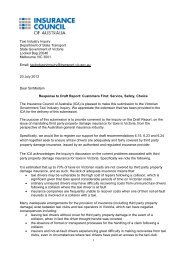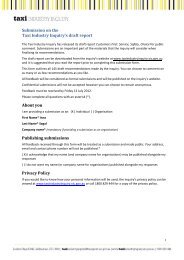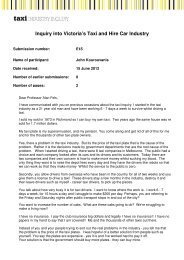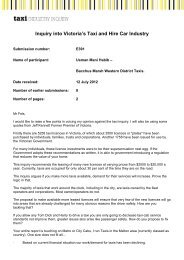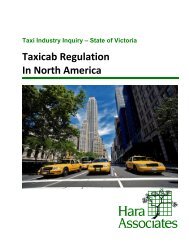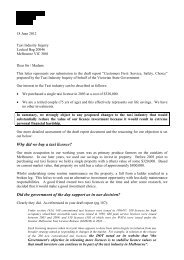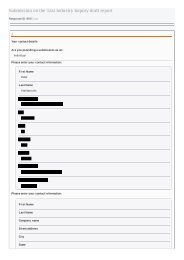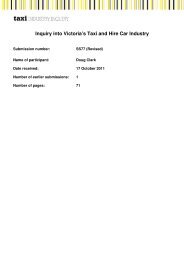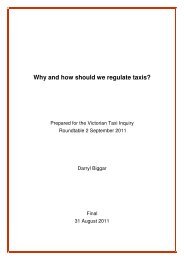Part D â Understanding and improving industry performance (PDF ...
Part D â Understanding and improving industry performance (PDF ...
Part D â Understanding and improving industry performance (PDF ...
You also want an ePaper? Increase the reach of your titles
YUMPU automatically turns print PDFs into web optimized ePapers that Google loves.
9.3.3. Quality <strong>and</strong> safety controls<br />
In its assessment of taxi regulation regimes, the OECD noted:<br />
Removing entry restrictions does not imply removing<br />
quality based regulation. Indeed, supportive<br />
regulation is a precondition for fully achieving the<br />
potential benefits of adopting an open entry policy.<br />
That said, remaining regulatory arrangements must<br />
not unduly inhibit the development of innovative<br />
service offers <strong>and</strong> <strong>industry</strong> models. 14<br />
Jurisdictions examined by the inquiry have taken<br />
different approaches to liberalisation by including in<br />
their approaches the introduction, maintenance or<br />
indeed strengthening of quality <strong>and</strong> safety regulations to<br />
encourage improvements in quality <strong>and</strong> safety st<strong>and</strong>ards.<br />
In New Zeal<strong>and</strong>, quality controls were imposed on<br />
st<strong>and</strong>ards for vehicles, driver competence <strong>and</strong> operator<br />
<strong>performance</strong> prior to liberalisation. These controls were<br />
maintained following liberalisation <strong>and</strong> strengthened<br />
several years into the reform. Today, new licence holders<br />
are subject to a ‘fit <strong>and</strong> proper person’ test <strong>and</strong> are<br />
required to be affiliated with an ATO, with ATOs subject<br />
to a number of minimum quality st<strong>and</strong>ards. Taxi drivers<br />
are subject to background criminal <strong>and</strong> annual medical<br />
checks, must pass a first aid course <strong>and</strong> must hold an<br />
‘area knowledge certificate’ for the area in which they<br />
operate. Specialist taxi enforcement staff conduct regular<br />
checks on vehicle compliance with requirements.<br />
In Sweden, despite liberalisation of entry <strong>and</strong> fares<br />
in 1990, quality controls were reinforced. Applicants<br />
were subject to more rigorous assessments in relation<br />
to competence in operating a taxi service, as well as<br />
their economic capacity <strong>and</strong> character. In 1995, stricter<br />
rules for drivers were introduced, with drivers subject<br />
to geographical knowledge tests <strong>and</strong> criminal checks.<br />
Sweden is considered to be one of the jurisdictions with<br />
the strictest requirements on taxi drivers. 15<br />
The Singapore L<strong>and</strong> Transport Authority introduced<br />
a new set of Quality of Service St<strong>and</strong>ards to ensure<br />
minimum service st<strong>and</strong>ards at the time of deregulating<br />
entry controls in 2003.<br />
In Phoenix, problems with service st<strong>and</strong>ards following<br />
entry <strong>and</strong> fare deregulation during the 1980s led to<br />
Arizona deciding to introduce background criminal<br />
checks for taxi drivers.<br />
There is a common theme that some minimum quality<br />
<strong>and</strong> safety controls are necessary to ensure adequate<br />
outcomes in this <strong>industry</strong>. As the OECD has observed:<br />
“deregulating taxi supply does not, in conceptual terms,<br />
necessarily imply removing or even downgrading quality<br />
regulations”. 16<br />
Indeed, quality regulations are critical to maintain higher<br />
quality services <strong>and</strong> avoid excessive entry (which lowers<br />
st<strong>and</strong>ards where competition is ineffective). For example,<br />
this has worked in London where, despite open entry,<br />
the barrier to entry via stringent quality controls on<br />
drivers (such as ‘The Knowledge’ test) <strong>and</strong> administrative<br />
delays still creates positive service outcomes (see case<br />
study). New Zeal<strong>and</strong>’s ATO model also ensures there are<br />
minimum quality st<strong>and</strong>ards in the taxi <strong>industry</strong>.<br />
The same arguments apply to the need for safety<br />
regulations, particularly due to asymmetric information<br />
about the safety of the taxi vehicle, driver <strong>and</strong>/or<br />
passenger prior to the service being delivered. It has<br />
been argued that entry restrictions themselves do not<br />
ensure safety st<strong>and</strong>ards for taxis, <strong>and</strong> well-targeted<br />
safety regulations are more appropriate. 17<br />
Different jurisdictions have maintained, reinforced<br />
<strong>and</strong>, in some cases, removed specific quality<br />
<strong>and</strong> safety controls. The inquiry considers that<br />
the level <strong>and</strong> effectiveness of these controls need<br />
to be well-considered <strong>and</strong> well-targeted.<br />
14 OECD (2007a), Op. Cit., p.10<br />
15 OECD (2007a), Op. Cit., p.48<br />
16 Bekken, J.T. (2007), ‘Experiences with (De)regulation in the European<br />
taxi <strong>industry</strong>’, in OECD (2007a), (De)regulation of the taxi <strong>industry</strong>,<br />
Economic Conference of Ministers of Transport, Round Table 133,<br />
p.48<br />
17 Productivity Commission (1999), Regulation of the Taxi Industry,<br />
Ausinfo, Canberra, p.12<br />
166





